Numerical Analysis of Internal Force Distribution in Combining Supporting Structures for Expansive Soil High Slope along Railway
Abstract
1. Introduction
2. Materials and Methods
2.1. Model Establishment and Meshing
2.2. Simulation of Experimental Conditions
2.3. Determination of Thermal Expansion Coefficient
- (1)
- Before the experiment starts, a certain amount of pressure is applied using the jack to ensure good contact between the various parts of the test system. The initial readings of the soil pressure box and the dial gauge are recorded.
- (2)
- Water is poured onto the surface of the test block, and the time and amount of water poured are recorded. A thin layer of water should always be maintained above the test block.
- (3)
- When the dial gauge reading on the load plate changes, the jack is adjusted promptly to return the dial gauge pointer to its initial value. The readings of the dial gauge and the soil pressure box are recorded before and after each adjustment of the jack, with observations being made every 10 min.
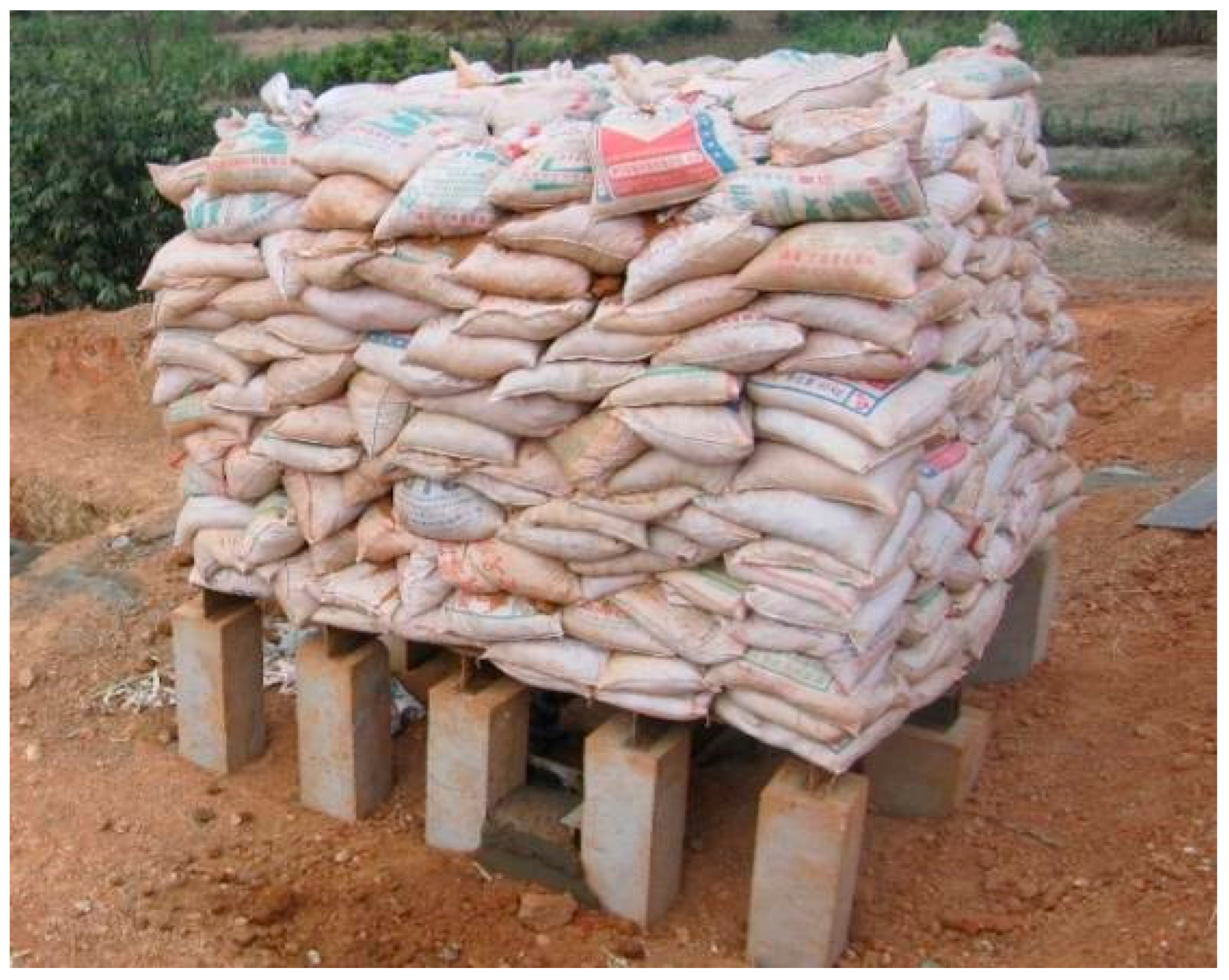
2.4. Case Study
2.4.1. Verification of Maximum Deformation
2.4.2. Verification of Safety Factor
2.4.3. Verification of Expansion Force
3. Results
3.1. Analysis of Pile Internal Forces
3.2. Influence of Pile Length on Internal Forces of Support Structure
3.2.1. Influence of Upper Pile Length
- (1)
- As the pile length decreases, the shear force maximum value in the upper part of the pile first increases and then decreases, exhibiting inverted C-shaped distribution. When the pile length is 15 m, it reaches the maximum value, at 1.1 times that of the base value. Considering rainfall, the shear force maximum value in the upper part increases with decreasing pile length, reaching a maximum of 1.25 times that of the base value. This suggests a noticeable influence of rainfall on the shear force maximum value in the upper part.
- (2)
- The shear force maximum value in the lower part of the pile first decreases, then increases, and then decreases again, forming S-shaped distribution. Considering rainfall, the shear force maximum value in the lower part increases first and then decreases, showing inverted C-shaped distribution. When the pile length is 16 m, it reaches the maximum value, at 1.04 times that of the base value. This indicates a significant influence of rainfall on the shear force maximum value in the lower part.
- (3)
- According to the principles of static equilibrium, the shear force in the upper part of the pile is equal to the horizontal component of the landslide thrust. Thus, when the pile length is 15 m, the pile bears the maximum landslide thrust.
- (4)
- The shear force in the lower part is the horizontal component of the anchoring force. Ideally, a larger value is better, but longer piles result in higher costs. Therefore, when considering slope safety, a shorter pile length is preferable. The software calculations reveal that, when the upper pile length is 15 m, the slope remains safe and reliable. Thus, it is recommended to set the upper pile length to 15 m.
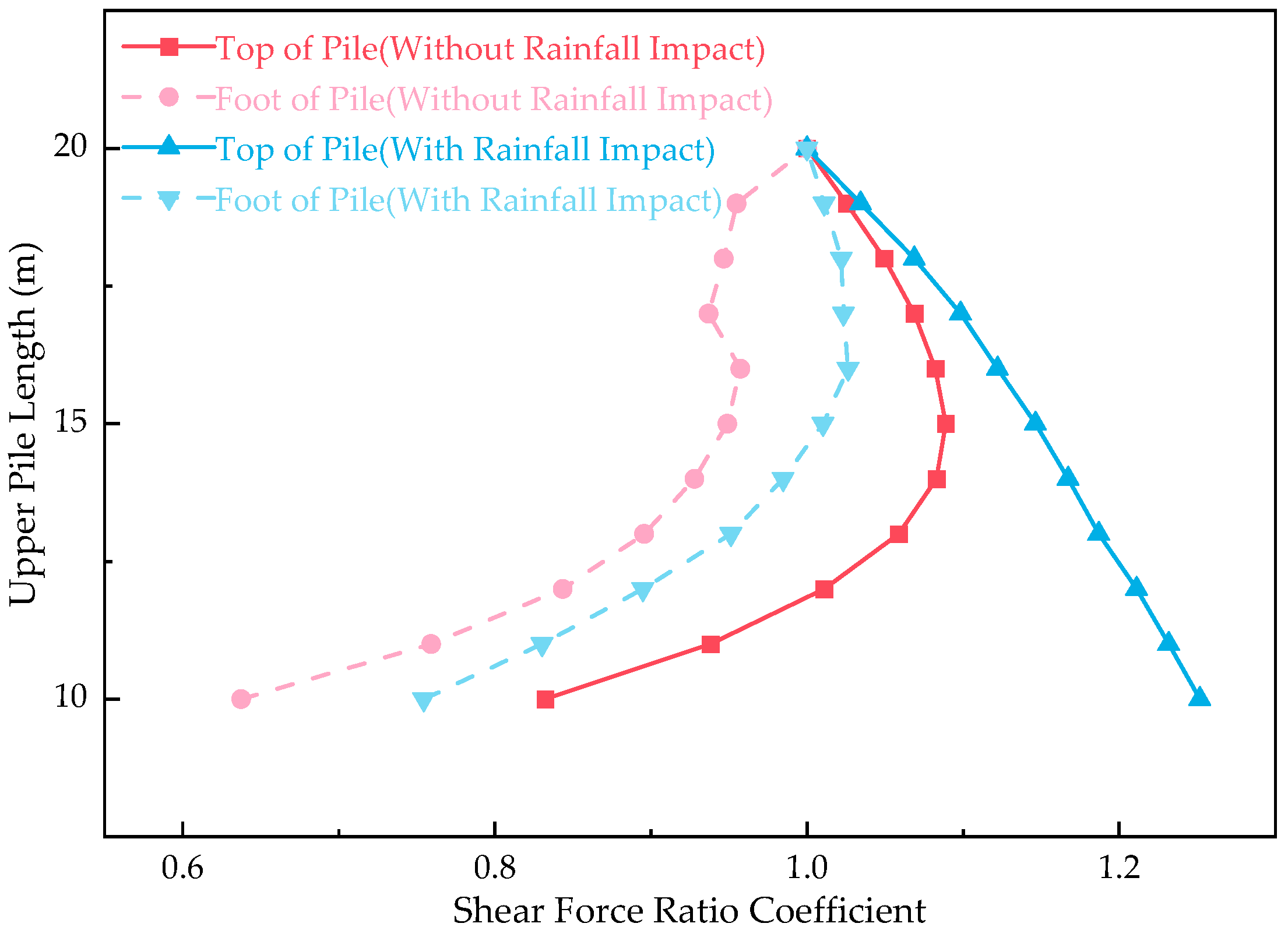
- (1)
- The lower pile bending moment maximum value does not show a clear change with variations in the upper pile length, suggesting a minor impact of the upper pile length on the lower pile bending moment. The upper pile bending moment maximum value nonlinearly decreases with decreasing pile length. When the pile length is 10 m, the bending moment is minimized, reaching 0.32 times that of the base value, mainly due to the decrease in the shear force and pile length.
- (2)
- After considering rainfall, the influence of changes in the upper pile length on the lower pile bending moment is still minor. The upper pile bending moment first decreases and then increases with decreasing pile length. When the pile length is 12 m, the bending moment is minimized, reaching 0.43 times that of the base value.

3.2.2. Influence of Lower Pile Length
- (1)
- The maximum shear force at the lower part of the pile increases as the pile length decreases. When the pile length is 8 m, the maximum shear force reaches 1.33 times that of the reference value. Considering the influence of rainfall, the pattern of the maximum shear force at the lower part remains consistent with the variation in pile length. However, when the pile length is 8 m, the maximum shear force becomes 1.39 times that of the reference value. This indicates that rainfall leads to an increase in the maximum shear force at the lower part of the pile.
- (2)
- No matter whether there is rainfall or not, the maximum shear value of the upper part of the pile increases and then decreases with the decrease in the length of the lower pile, showing an anti-C distribution. In addition, when the pile length is 11 m, the maximum value is taken, and the maximum value is 1.1 times that of the base. It can be seen that, when considering the influence of the lower pile length, the rainfall has very little influence on the maximum shear value of the upper part of the pile.
- (3)
- According to the software calculations, when the lower pile length is 11 m, the slope remains safe and reliable. Therefore, it is recommended to set the lower pile length to 11 m.

- (1)
- The maximum bending moment of the upper pile body shows little variation with changes in the lower pile length. This suggests that changes in the lower pile length have a minor impact on the maximum bending moment of the upper pile body. Considering the influence of rainfall, the variation in the lower pile length has a similarly minor effect on the maximum bending moment of the upper pile body.
- (2)
- The maximum bending moment of the lower pile body initially increases and then decreases, showing reverse ‘C’-shaped distribution. When the pile length is 11 m, the maximum value is 1.2 times that of the reference value. The variation pattern of the maximum bending moment of the lower pile body is consistent with the pattern of the upper pile shear force with changes in pile length. Considering the impact of rainfall, the variation pattern of the maximum bending moment of the lower pile body remains consistent with changes in pile length. When the pile length is 11 m, the maximum bending moment becomes 1.18 times that of the reference value. Rainfall leads to an increase in the maximum bending moment of the lower pile body.
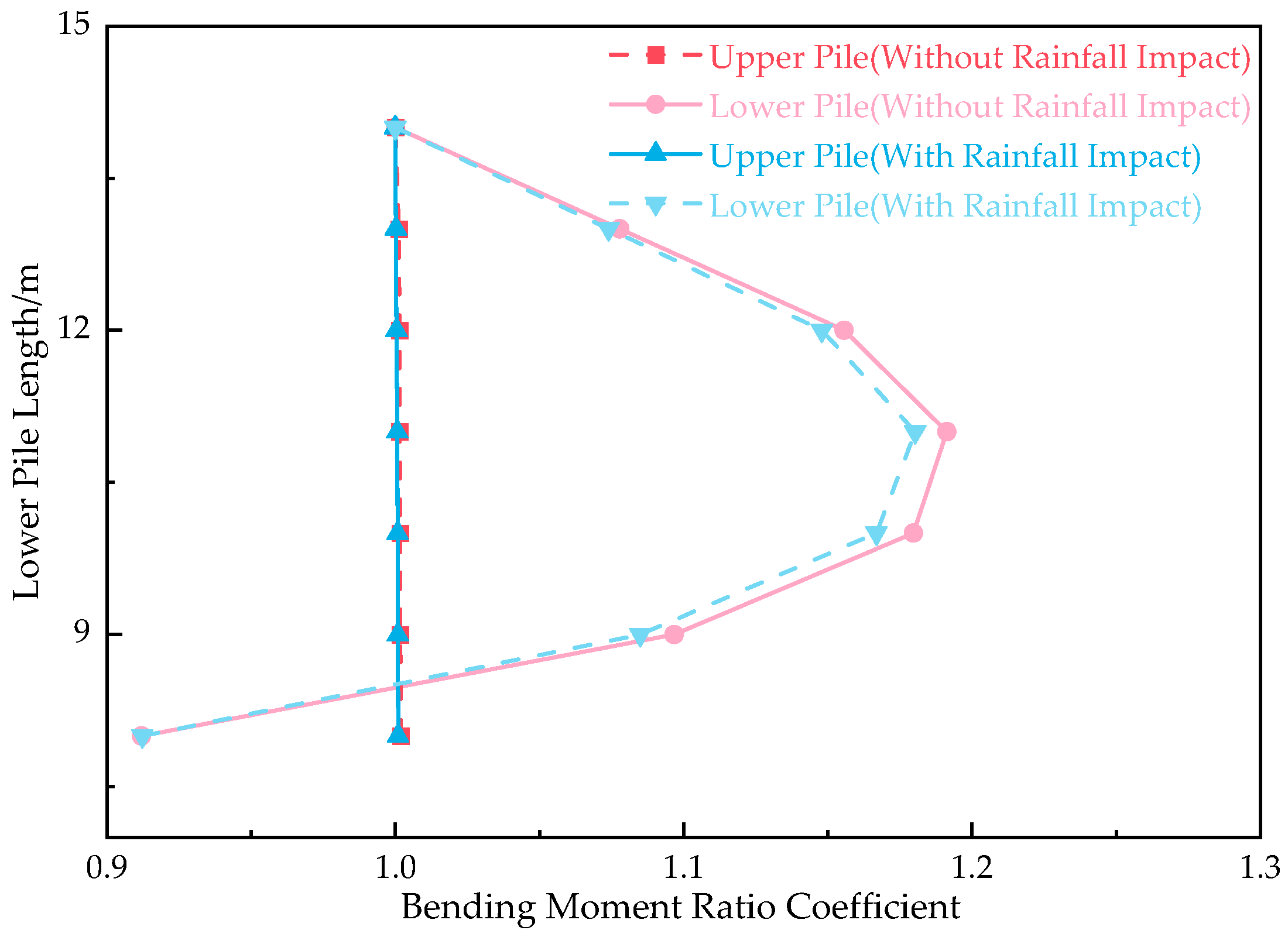
3.3. Anti-Sliding Pile Optimization
4. Discussion
5. Conclusions
- (1)
- An approximate method for calculating the humidity stress field of expansive soil, based on the equivalent humidity stress field of the temperature field, was proposed to simulate the impact of rainfall on the expansive soil slope. The relevant parameters were determined through a combination of numerical simulation and in situ testing.
- (2)
- Both upper and lower piles exhibit distinct patterns in their shear force and bending moment distributions along their bodies. In the cantilever section of both piles, the shear force gradually decreases, while, in the anchorage section, it first increases and then decreases. The bending moment along the upper pile body shows an increase–decrease–increase pattern, whereas the lower pile body exhibits a decrease–increase–decrease–increase pattern. Notably, the bending moment along the longitudinal axis of the lower anti-sliding pile demonstrates a characteristic “W” shape.
- (3)
- Decreasing the length of the upper anti-sliding pile results in an initial increase followed by a decrease in the maximum shear force in its upper part, forming inverted “C” distribution. Conversely, the maximum shear force in the lower part of the upper pile initially decreases and then increases, showing “S” distribution. Considering the influence of rainfall, the maximum shear force in the lower part of the pile initially increases and then decreases, displaying inverted “C” distribution. Rainfall notably impacts the maximum shear forces in both the upper and lower parts of the upper pile.
- (4)
- Similarly, reducing the length of the lower anti-sliding pile leads to an initial increase followed by a decrease in the maximum shear force in its upper part, resulting in inverted “C” distribution. Meanwhile, the maximum shear force in the lower part of the lower pile increases. The rainfall has very little influence on the maximum shear value of the pile.
Author Contributions
Funding
Data Availability Statement
Conflicts of Interest
References
- Pei, P.; Zhao, Y.L.; Ni, P.P.; Mei, G.X. A protective measure for expansive soil slopes based on moisture content control. Eng. Geol. 2020, 269, 105527. [Google Scholar] [CrossRef]
- Jiang, G.; Chen, W.; Liu, X.; Yuan, S.; Wu, L.; Zhang, C. Field study on swelling-shrinkage response of an expansive soil foundation under high-speed railway embankment loads. Soils Found. 2018, 58, 1538–1552. [Google Scholar] [CrossRef]
- Chen, W.; Sun, D.; Zhang, J. The maximum shear modulus of expansive soil during wetting-drying processes and its prediction. Hydrogeol. Eng. Geol. 2021, 48, 89–96. [Google Scholar]
- Jiang, Z.; Zeng, L.; Li, A. Technical research on subgrade slope engineering in construction of Nanning-Kunming Railway. Chin. J. Rock Mech. Eng. 2002, 09, 1408–1414. [Google Scholar]
- Feng, Z.J.; Feng, J.D.; Xue, Y.; Yang, G.; He, X. Application of flexible retaining walls in the engineering of strong expansive soil cut slopes on the Yungui Railway. High-Speed Railw. Technol. 2012, 3, 71–73+78. [Google Scholar]
- Comodromos, E.M.; Papadopoulou, M.C. Pile foundation analysis and design using experimental data and 3-D numerical analysis. Comput. Geotech. 2009, 36, 819–836. [Google Scholar] [CrossRef]
- Kim, Y.; Jeong, S.S. Analysis of soil resistance on laterally loaded piles based on 3D soil–pile interaction. Comput. Geotech. 2011, 38, 248–257. [Google Scholar] [CrossRef]
- Yang, X.X.; Ren, J. Diseases features and treatment measures of expansive-soil channel slope. Adv. Mater. Res. 2012, 430–432, 1390–1394. [Google Scholar] [CrossRef]
- Tang, X.Y.; Li, Y.P. Treatment technology for embankment landslide caused by expansive soil foundation instability. Appl. Mech. Mater. 2012, 204–208, 3035–3039. [Google Scholar] [CrossRef]
- Sun, H.; Hu, B. Analysis of fissured expansive soil slope stability and its reinforcement with anti-slippery piles. Appl. Mech. Mater. 2013, 275–277, 1489–1492. [Google Scholar] [CrossRef]
- He, H.; Xu, Y. A study on micro pile reinforcement technology for the accumulative landslide of expansive soil. Appl. Mech. Mater. 2014, 580–583, 544–551. [Google Scholar] [CrossRef]
- Cai, F.; Ugai, K. Numerical analysis of the stability of a slope reinforced with piles. Soils Found. 2000, 40, 73–84. [Google Scholar] [CrossRef]
- Won, J.; You, K.; Jeong, S.; Kim, S. Coupled effects in stability analysis of pile-slope systems. Comput. Geotech. 2005, 32, 304–315. [Google Scholar] [CrossRef]
- Nian, T.K.; Chen, G.Q.; Luan, M.T.; Yang, Q.; Zheng, D.F. Limit analysis of the stability of slopes reinforced with piles against landslide in nonhomogeneous and anisotropic soils. Can. Geotech. J. 2008, 45, 1092–1103. [Google Scholar] [CrossRef]
- Kanagasabai, S.; Smethurst, J.A.; Powrie, W. Three-dimensional numerical modelling of discrete piles used to stabilize landslides. Can. Geotech. J. 2011, 48, 1393–1411. [Google Scholar] [CrossRef]
- Gao, Y.; Ye, M.; Zhang, F. Three-dimensional analysis of slopes reinforced with piles. J. Cent. South Univ. 2015, 22, 2322–2327. [Google Scholar] [CrossRef]
- Zhang, Y. A preliminary analysis of the distribution of lateral pressure on retaining walls with expansive clay backfill. China Railw. Sci. 1993, 14, 90–99. [Google Scholar]
- Richards, B. Pressures on a retaining wall by an expansive clay. In Proceedings of the 9th International Conference on Soil Mechanics and Foundation Engineering, Dallas, TX, USA, 11 July 1977; pp. 705–710. [Google Scholar]
- Mohamed, O.; Taha, Y.; El-Aziz, E. Field study of the distribution of lateral swelling pressure of expansive soil on retaining structure. JES J. Eng. Sci. 2014, 42, 289–302. [Google Scholar] [CrossRef]
- Khattab, S.; Al-Shamam, M.; Al-Juari, K. Model test on lateral earth pressure of highly expansive soil. In Unsaturated Soil Mechanics—From Theory to Practice; CRC Press: Boca Raton, FL, USA, 2015; pp. 709–716. [Google Scholar]
- Kassiff, G.; Zeitlen, J. Lateral swelling pressure on conduits from expansive clay backfill. Highw. Res. Board Bull. 1962, 313, 1–11. [Google Scholar]
- Wang, H.; Zhang, L.; Shi, C.; Zhao, L.; Zhang, Y. Comparative Study of Anti-Slide Pile Reinforcement Schemes for Expansive Soil Canal Slopes in Cold and Arid Regions. KSCE J. Civ. Eng. 2024, 28, 3741–3757. [Google Scholar] [CrossRef]
- Zhang, R.; Liu, Z.; Zheng, J.; Zhang, J. Experimental evaluation of lateral swelling pressure of expansive soil fill behind a retaining wall. J. Mater. Civ. Eng. 2020, 32, 04019360. [Google Scholar] [CrossRef]
- Lin, Y.; Zhang, Z.; Luo, G.; Xiao, H.; Yang, G.; Lu, L.; Duan, J. Analysis of lateral swelling pressure of expansive soil slope and internal force of pile-sheet structure. J. Cent. South Univ. (Sci. Technol.) 2022, 53, 140–149. [Google Scholar]
- Yang, G.; Li, Q.; Duan, J.; Luo, G.; Xiao, H.; Yang, T. Field investigation on mechanical properties of multi-stage combined supporting structure for expansive soil high slopes. J. Cent. South Univ. (Sci. Technol.) 2022, 53, 171–180. [Google Scholar] [CrossRef]
- Yang, Q.; Li, R.; Zhang, S.; Li, R.; Bai, W.; Xiao, H. Algorithm Implementation of Equivalent Expansive Force in Strength Reduction FEM and Its Application in the Stability of Expansive Soil Slope. Water 2022, 14, 1540. [Google Scholar] [CrossRef]
- Wang, A.; Xu, Y.; Xu, Y. Numerical modeling on the deformation features of expansive soil slopes under moisture variations based on fractal model. Comput. Geotech. 2024, 165, 105900. [Google Scholar] [CrossRef]
- Zhang, R.; Long, M.; Lan, T.; Zheng, J.; Geoff, C. Stability analysis method of geogrid reinforced expansive soil slopes and its engineering application. J. Cent. South Univ. 2020, 27, 1965–1980. [Google Scholar] [CrossRef]
- Mei, G.; Zhang, F.; Wei, J.; Yuan, J. Analysis of the expansive soil slope on anti-slide pile with finite element method. J. Jiangsu Univ. Sci. Technol. (Nat. Sci. Ed.) 2010, 2, 130–133. [Google Scholar]
- Li, X.Y.; Jia, G.L.; Yang, G.L.; Deng, Z.H.; Wang, P.F. Field test study of pile-anchor wall on expansive soil cut slope. Constr. Technol. 2022, 51, 94–97+103. [Google Scholar]
- Jiang, H.; Xing, L. Deformation mechanism and treatment effect of deeply excavated expansive soil slopes with high groundwater level: Case study of MR-SNWTP, China. Transp. Geotech. 2024, 46, 101253. [Google Scholar]
- Fan, K.; Zou, W.; Zhang, P.; Wang, X.; Shen, Y. Laboratory investigation and theoretical analysis of lateral pressure exerted by expansive soils on retaining walls with expanded polystyrene geofoam block upon water infiltration. Geotext. Geomembr. 2024, 52, 332–341. [Google Scholar] [CrossRef]
- Liu, G.Y.; Zhong, Z.R.; Ma, K.; Bo, W.; Zhao, P.H.; Li, Y.X.; Zhang, Z.P.; Zhang, P. Field experimental verifications of 3D DDA and its applications to kinematic evolutions of rockfalls. Int. J. Rock Mech. Min. Sci. 2024, 175, 105687. [Google Scholar] [CrossRef]
- Liu, G.Y.; Meng, H.Y.; Song, G.Y.; Bo, W.; Zhao, P.H.; Ning, B.K.; Xu, X.L. Numerical simulation of wedge failure of rock slopes using three-dimensional discontinuous deformation analysis. Environ. Earth Sci. 2024, 83, 310. [Google Scholar] [CrossRef]
- Liu, G.Y.; Zhong, Z.R.; Ye, T.J.; Meng, J.; Zhao, S.Z.; Liu, J.J.; Luo, S.Y. Impact failure and disaster processes associated with rockfalls based on three-dimensional discontinuous deformation analysis. Earth Surf. Process. Landf. 2024, 49, 3344–3366. [Google Scholar] [CrossRef]
- Wang, K.; Diao, X.H. A constitutive model for humidity stress field of expansive rocks. Chin. J. Rock Mech. Eng. 2015, S2, 3781–3792. [Google Scholar]
- Li, Q. Application of ANSYS in Civil Engineering; Posts and Telecom Press: Beijing, China, 2005. [Google Scholar]
- Hu, Y.N.; Ji, J.; Sun, Z.B.; Dias, D. First order reliability-based design optimization of 3D pile-reinforced slopes with Pareto optimality. Comput. Geotech. 2023, 162, 105635. [Google Scholar] [CrossRef]


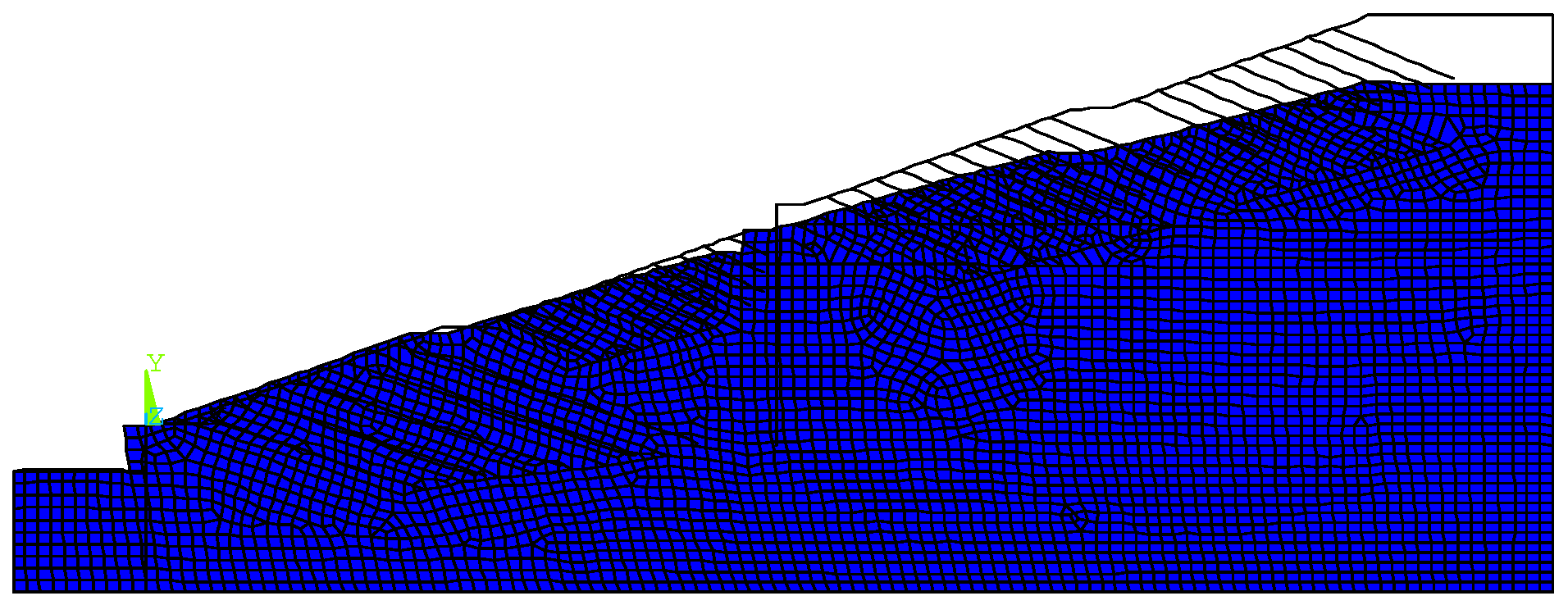
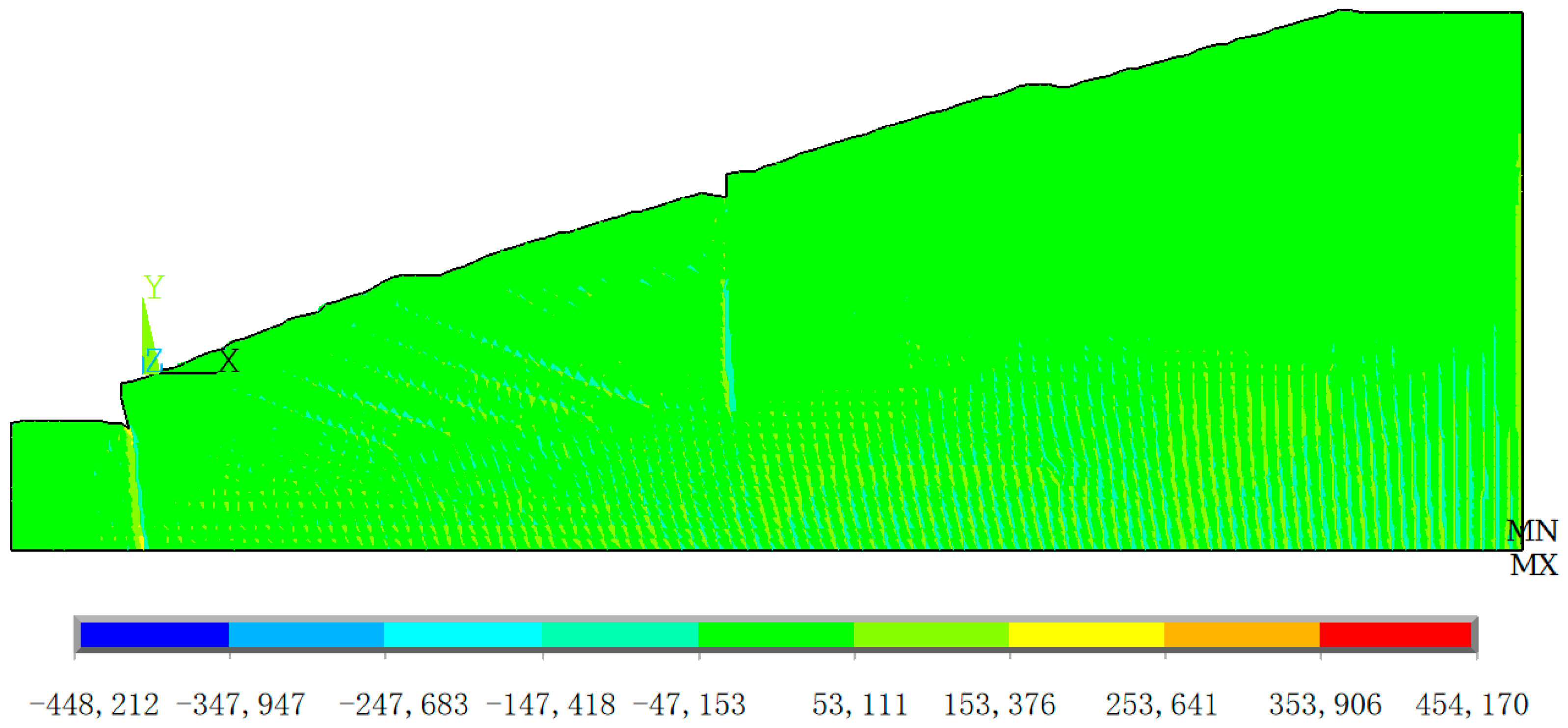
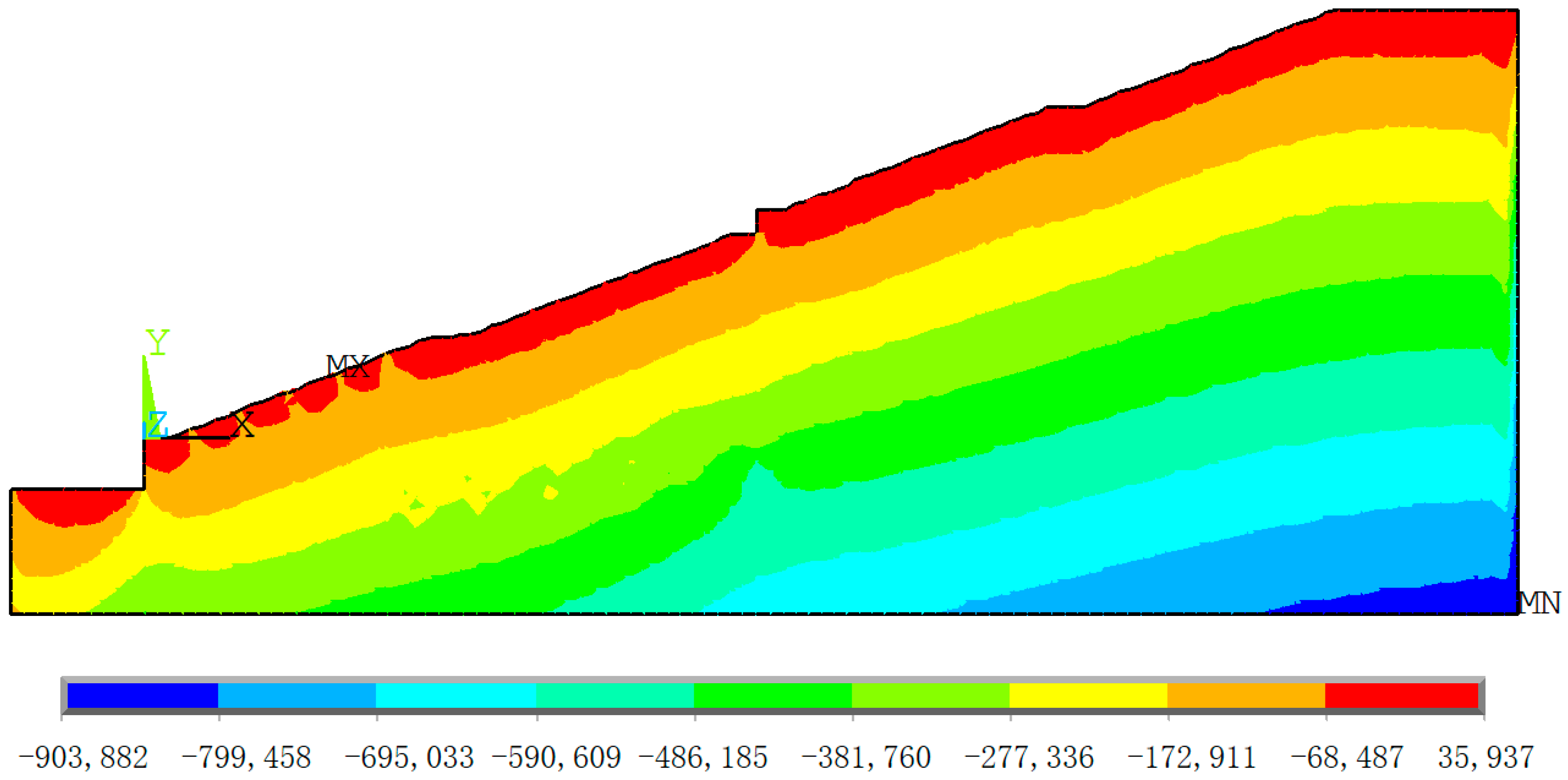

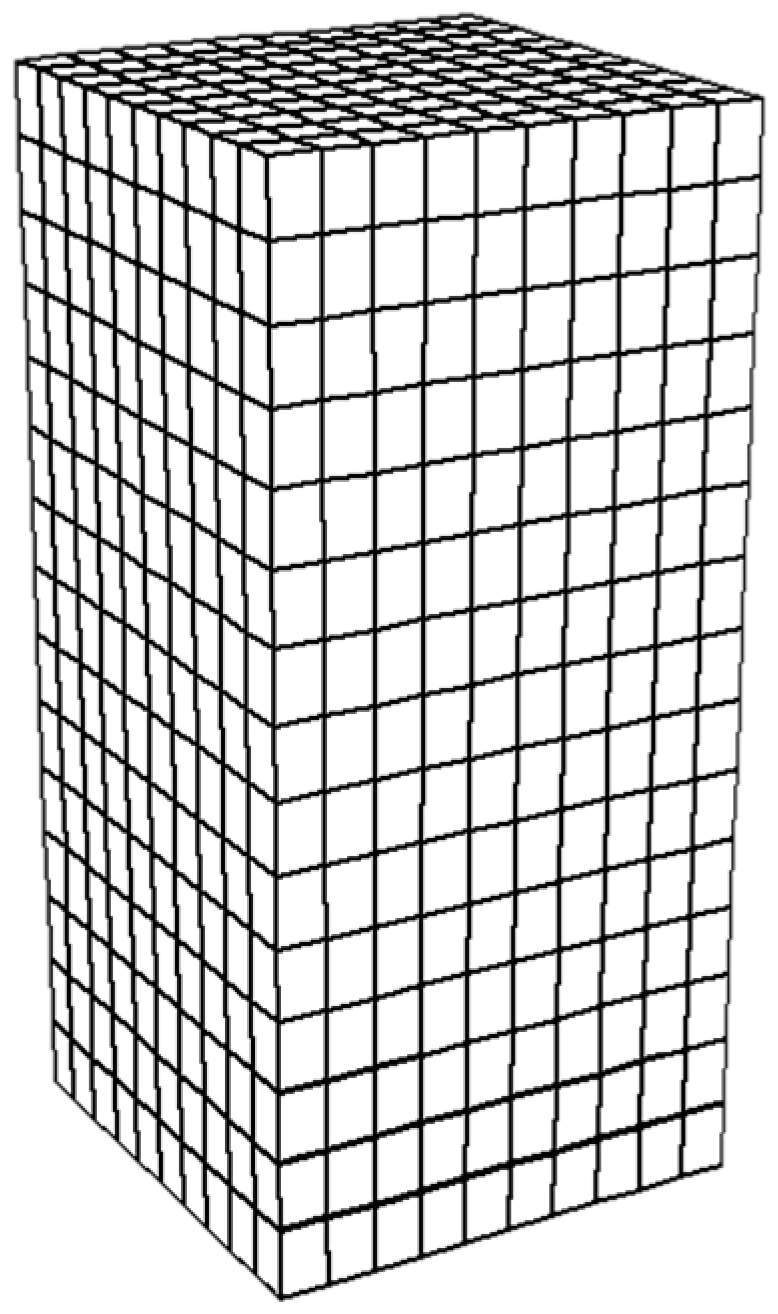
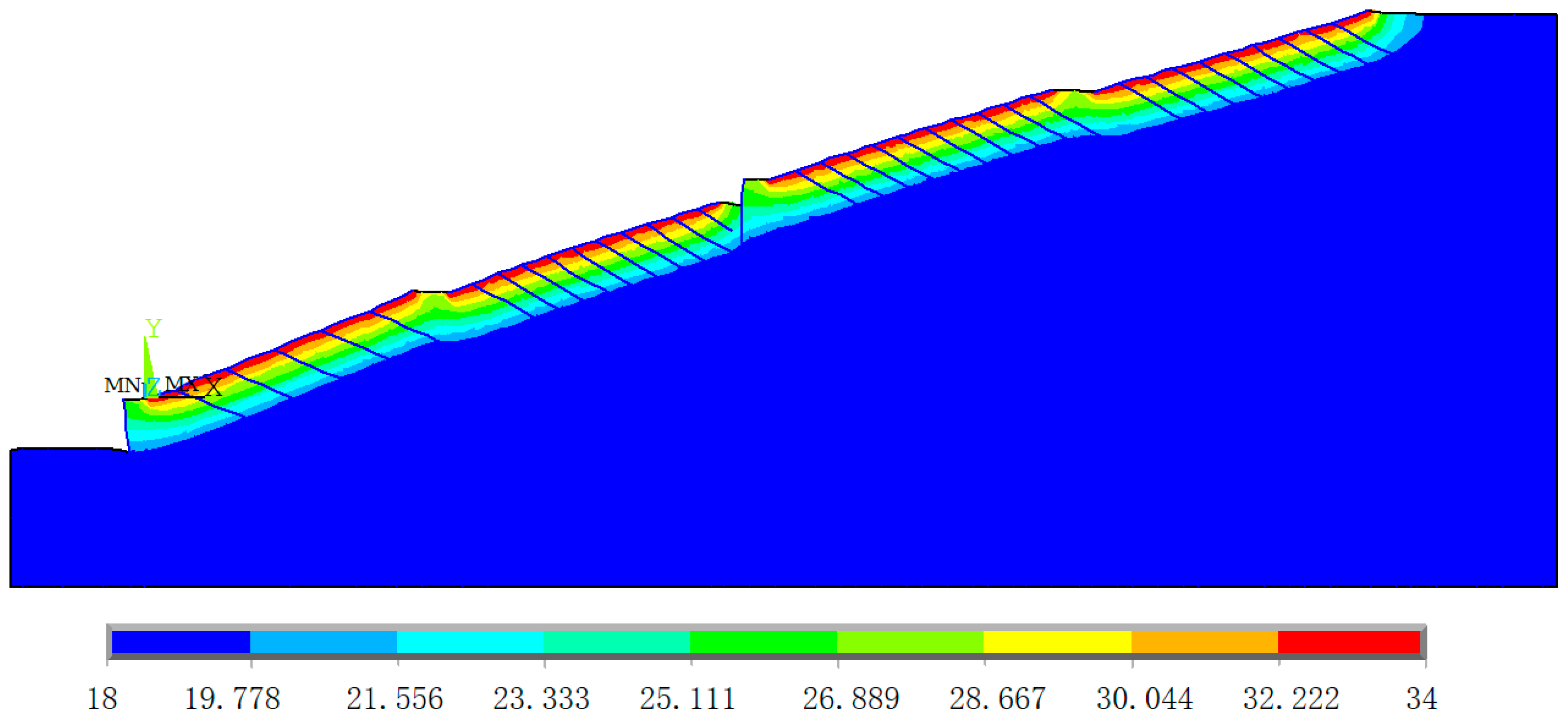

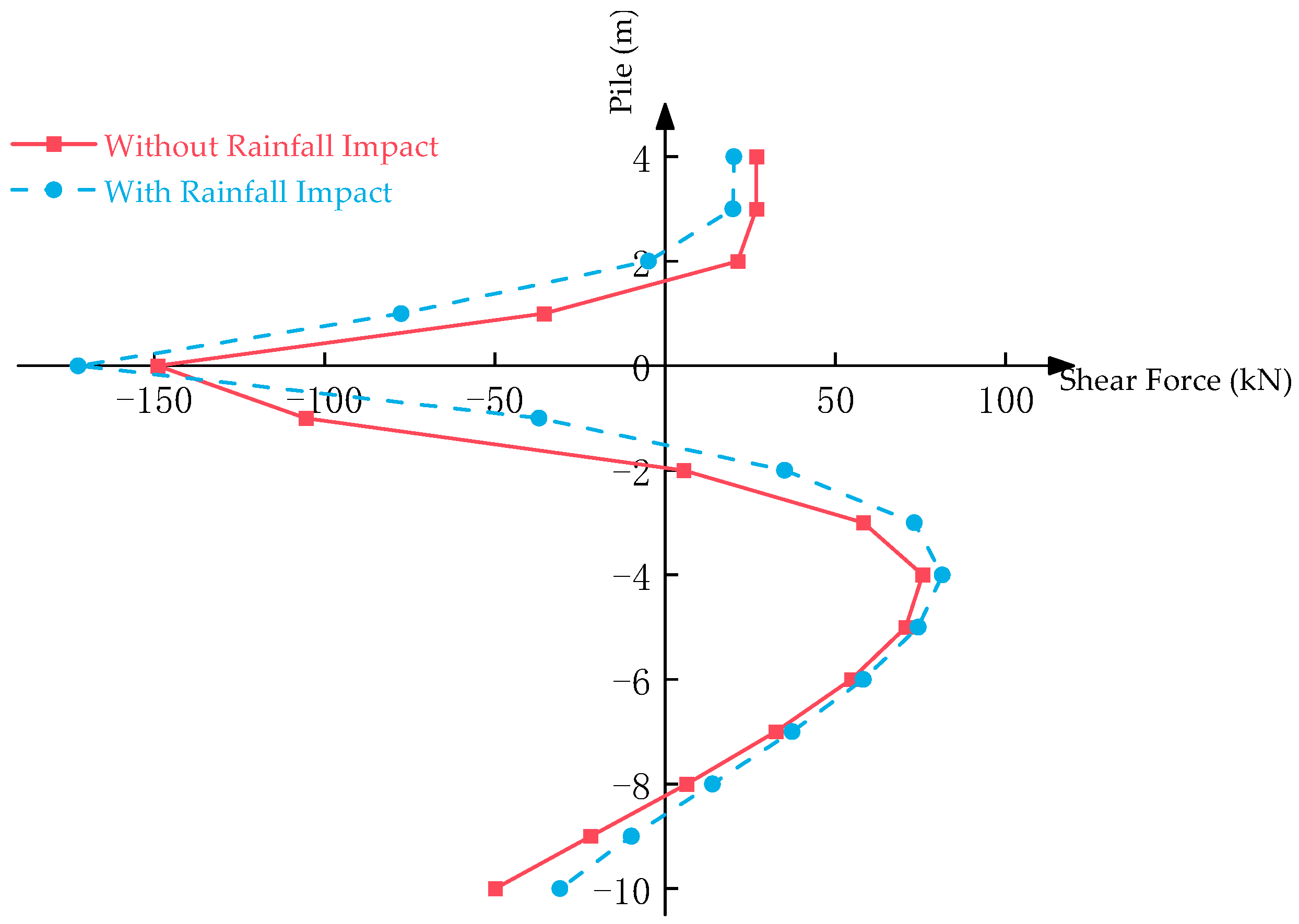
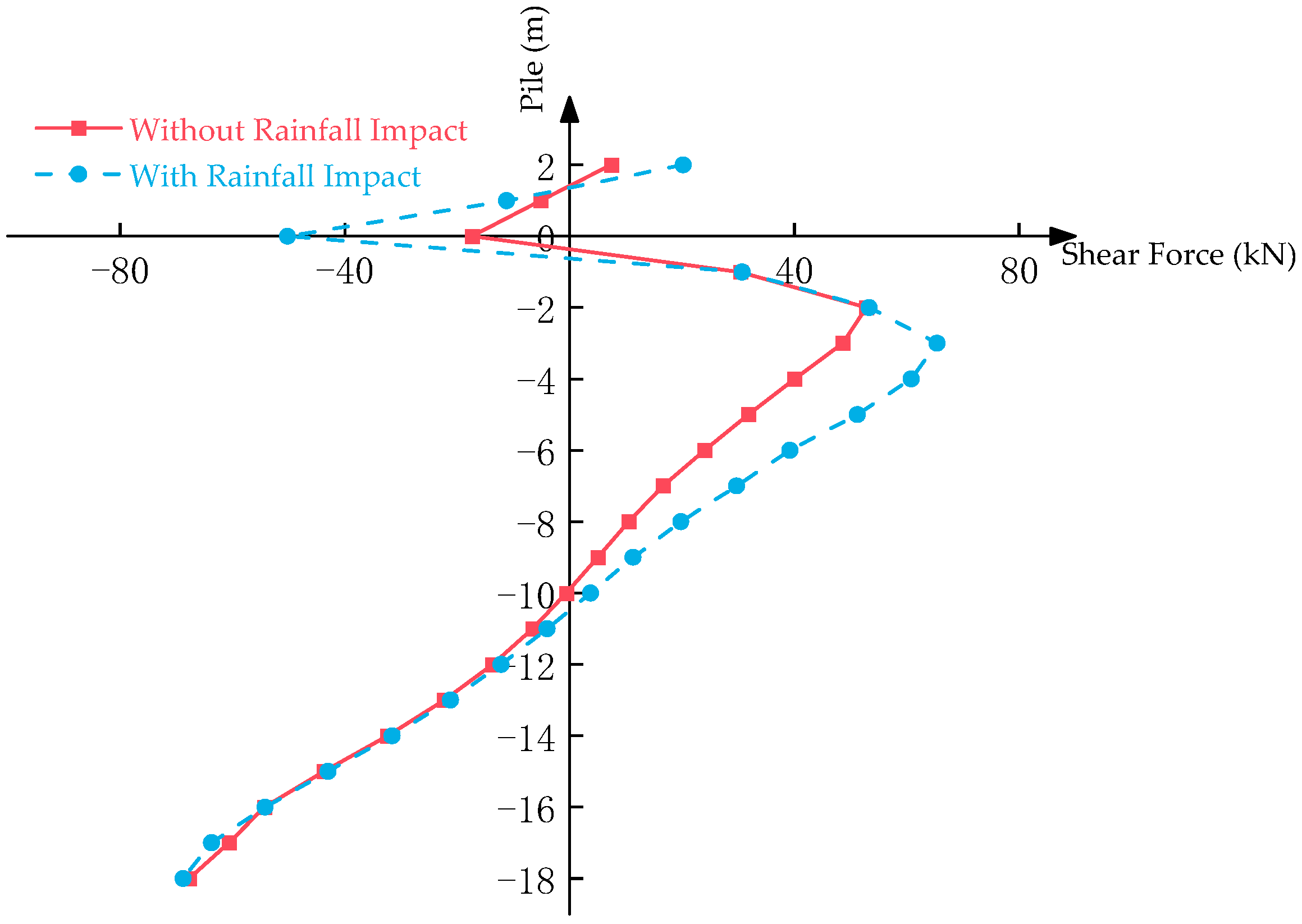

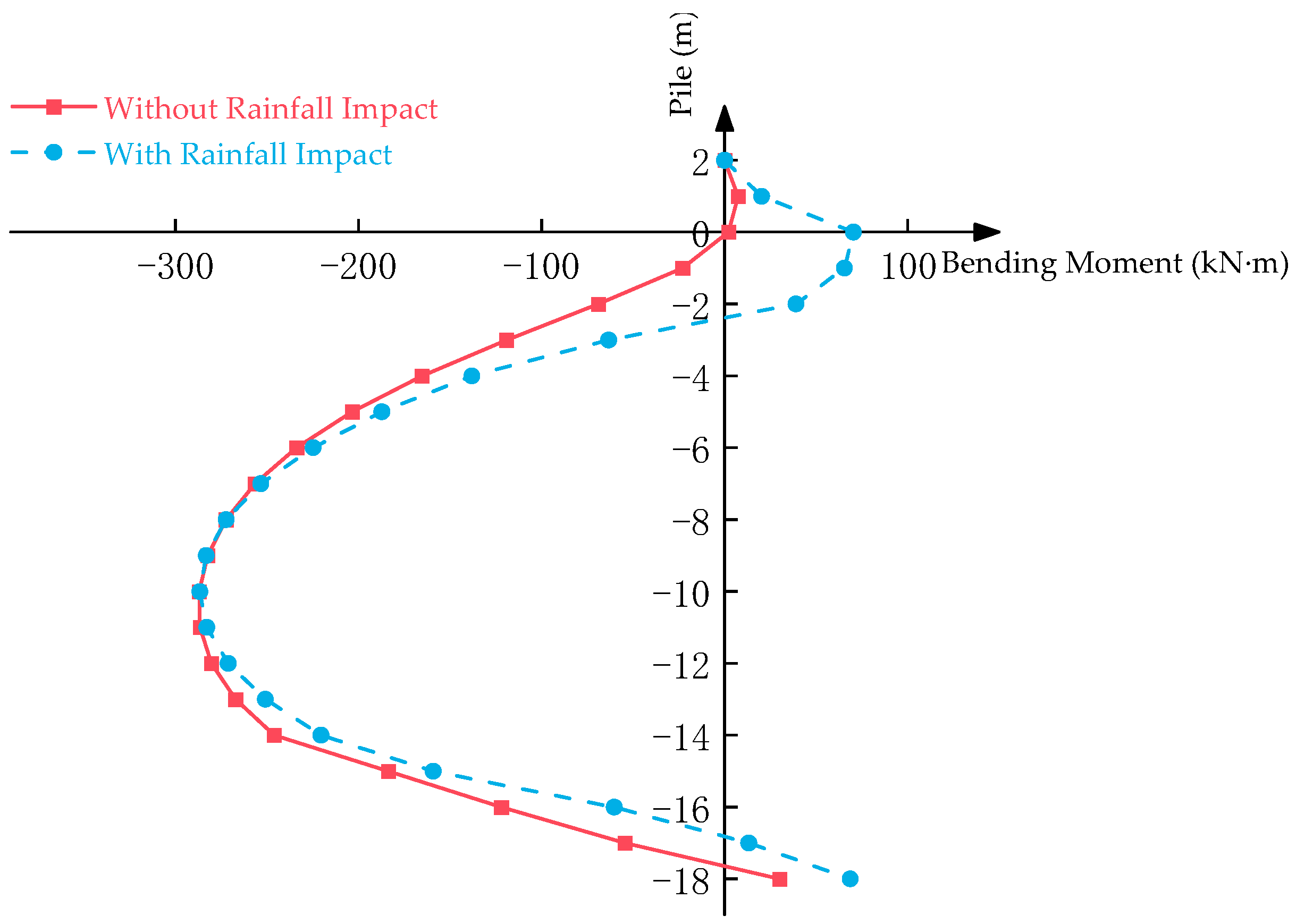
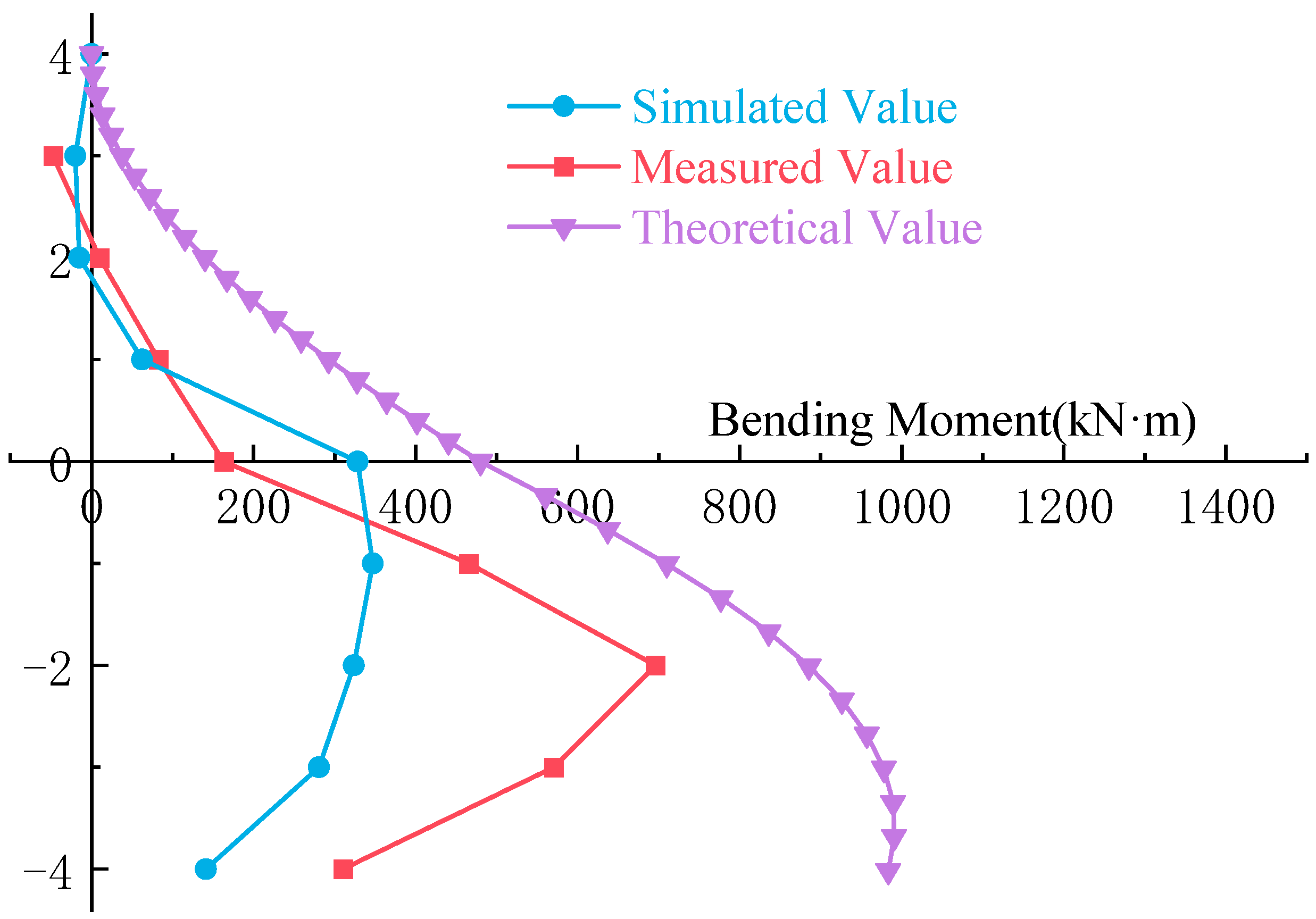
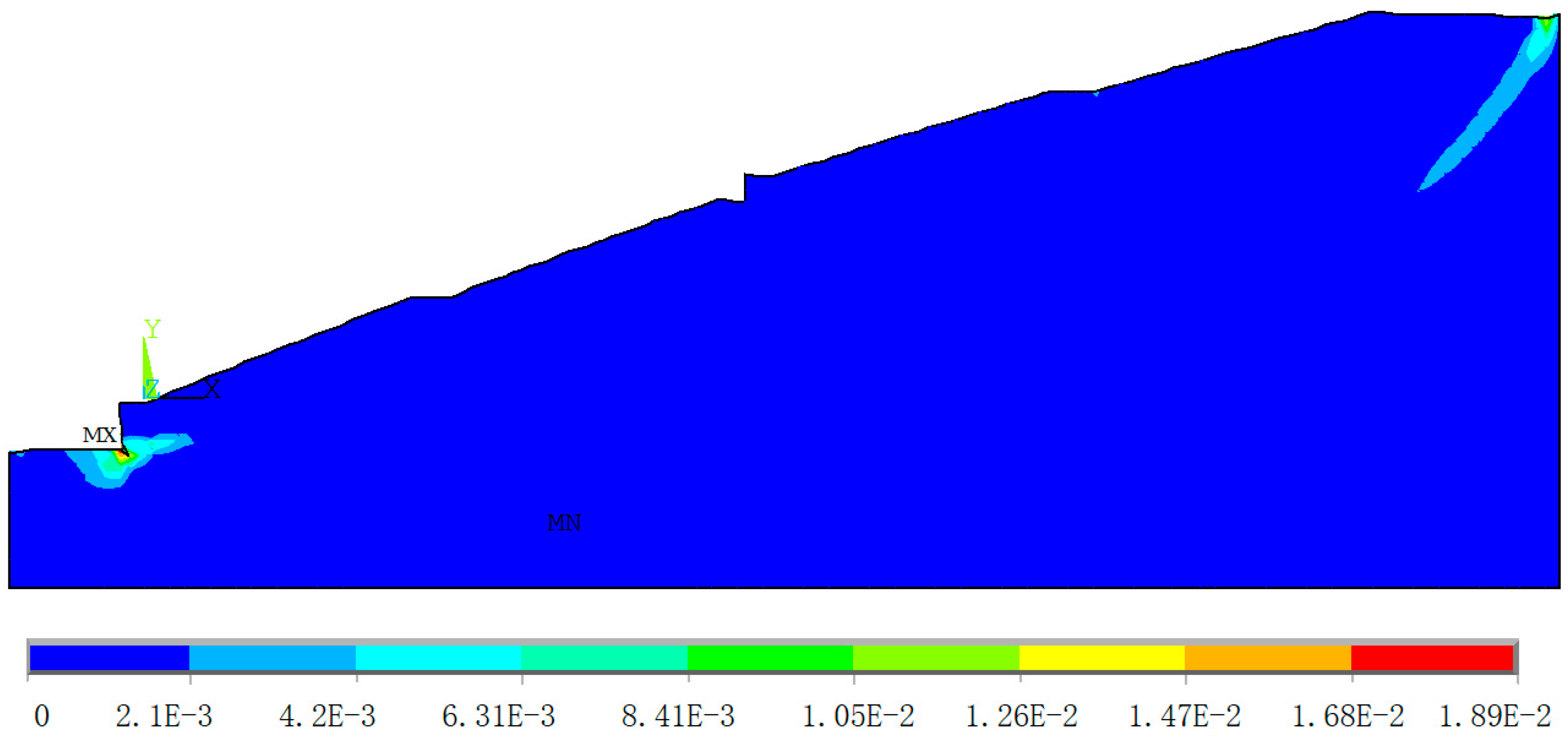
| Location | Constitutive Model | Thickness (m) | Elastic Modulus (MPa) | Poisson’s Ratio | Density (kg/m3) | Cohesion (kPa) | Internal Friction Angle (°) |
|---|---|---|---|---|---|---|---|
| Mid-Strong Expansive Soil | Mohr–Coulomb Model | 2 | 315 | 0.32 | 1900 | 25 | 13 |
| Mudstone with Clayey Sandstone | Mohr–Coulomb Model | 8 | 1100 | 0.33 | 2000 | 20 | 16 |
| Mudstone with Clayey Sandstone | Mohr–Coulomb Model | 6 | 1100 | 0.33 | 2200 | 15 | 20 |
| Mudstone with Clayey Sandstone and Lignite | Mohr–Coulomb Model | 22 | 1500 | 0.25 | 2300 | 15 | 15 |
| C35 Reinforced Concrete | Elastic Model | — | 31,500 | 0.2 | 2400 | — | — |
| C25 Reinforced Concrete | Elastic Model | — | 2500 | 0.2 | 2400 | — | — |
| Anchor Cable and Anchor Rod | Elastic Model | — | 195,000 | 0.3 | 7800 | — | — |
| Comparison | Case 1 | This Paper | Case 2 | This Paper |
|---|---|---|---|---|
| Max Deformation (mm) | 4 | 4 | 4.075 | 4.069 |
| Method Comparison | FLAC Finite Difference Strength Reduction | ANSYS Finite Element Strength Reduction |
|---|---|---|
| Safety Factor (K) | 1.24 | 1.23 |
| Diameter (mm) | Height (mm) | Volumetric Water Content | Vertical Pressure (kPa) | Initial Deformation Modulus (MPa) | Stable Deformation Modulus (MPa) | Reference Calculation | This Paper Calculation | ||
|---|---|---|---|---|---|---|---|---|---|
| Vertical Stress (kPa) | Displacement (mm) | Vertical Stress (kPa) | Displacement (mm) | ||||||
| 79.8 | 20 | 0.29 | 100 | 6.23 | 0.9 | 99 | 0.98 | 99 | 0.975 |
| Upper Pile Length (m) | Without Rainfall Impact | With Rainfall Impact | ||||
|---|---|---|---|---|---|---|
| Anchor Cable Frame Beam | Anchor Rod Frame Beam | Anchor Cable Frame Beam | Anchor Rod Frame Beam | |||
| Maximum Bending Moment (kN·m) | Maximum Bending Moment (kN·m) | Maximum Anchor Rod Pull (kN) | Maximum Bending Moment (kN·m) | Maximum Bending Moment (kN·m) | Maximum Anchor Rod Pull (kN) | |
| 10 | 9.18 | 1 | 2.62 | 18.6 | 1.18 | 3.73 |
| 11 | 9.18 | 1 | 2.62 | 18.6 | 1.19 | 3.74 |
| 12 | 9.18 | 1.01 | 2.63 | 18.6 | 1.19 | 3.76 |
| 13 | 9.18 | 1.01 | 2.63 | 18.6 | 1.2 | 3.77 |
| 14 | 9.18 | 1.02 | 2.64 | 18.6 | 1.2 | 3.78 |
| 15 | 9.18 | 1.03 | 2.64 | 18.6 | 1.21 | 3.8 |
| 16 | 9.17 | 1.03 | 2.64 | 18.6 | 1.22 | 3.81 |
| 17 | 9.17 | 1.03 | 2.64 | 18.6 | 1.22 | 3.82 |
| 18 | 9.17 | 1.03 | 2.64 | 18.6 | 1.23 | 3.84 |
| 19 | 9.17 | 1.03 | 2.64 | 18.59 | 1.23 | 3.85 |
| 20 | 9.17 | 1.03 | 2.64 | 18.59 | 1.24 | 3.86 |
| Lower Pile Length (m) | Without Expansion Load | With Expansion Load | ||||
|---|---|---|---|---|---|---|
| Anchor Cable Frame Beam | Anchor Rod Frame Beam | Anchor Cable Frame Beam | Anchor Rod Frame Beam | |||
| Maximum Bending Moment (kN·m) | Maximum Bending Moment (kN·m) | Maximum Anchor Rod Pull (kN) | Maximum Bending Moment (kN·m) | Maximum Bending Moment (kN·m) | Maximum Anchor Rod Pull (kN) | |
| 8 | 9.16 | 1.02 | 2.63 | 18.55 | 1.23 | 3.73 |
| 9 | 9.16 | 1.02 | 2.64 | 18.55 | 1.23 | 3.73 |
| 10 | 9.16 | 1.02 | 2.64 | 18.55 | 1.23 | 3.73 |
| 11 | 9.16 | 1.02 | 2.64 | 18.55 | 1.23 | 3.73 |
| 12 | 9.16 | 1.02 | 2.64 | 18.55 | 1.23 | 3.73 |
| 13 | 9.16 | 1.03 | 2.64 | 18.55 | 1.23 | 3.73 |
| 14 | 9.16 | 1.03 | 2.64 | 18.55 | 1.23 | 3.73 |
Disclaimer/Publisher’s Note: The statements, opinions and data contained in all publications are solely those of the individual author(s) and contributor(s) and not of MDPI and/or the editor(s). MDPI and/or the editor(s) disclaim responsibility for any injury to people or property resulting from any ideas, methods, instructions or products referred to in the content. |
© 2024 by the authors. Licensee MDPI, Basel, Switzerland. This article is an open access article distributed under the terms and conditions of the Creative Commons Attribution (CC BY) license (https://creativecommons.org/licenses/by/4.0/).
Share and Cite
Yan, Y.; Zhang, Y.; Shen, Q.; Wang, C. Numerical Analysis of Internal Force Distribution in Combining Supporting Structures for Expansive Soil High Slope along Railway. Buildings 2024, 14, 3081. https://doi.org/10.3390/buildings14103081
Yan Y, Zhang Y, Shen Q, Wang C. Numerical Analysis of Internal Force Distribution in Combining Supporting Structures for Expansive Soil High Slope along Railway. Buildings. 2024; 14(10):3081. https://doi.org/10.3390/buildings14103081
Chicago/Turabian StyleYan, Yuan, Yidan Zhang, Quan Shen, and Chaohui Wang. 2024. "Numerical Analysis of Internal Force Distribution in Combining Supporting Structures for Expansive Soil High Slope along Railway" Buildings 14, no. 10: 3081. https://doi.org/10.3390/buildings14103081
APA StyleYan, Y., Zhang, Y., Shen, Q., & Wang, C. (2024). Numerical Analysis of Internal Force Distribution in Combining Supporting Structures for Expansive Soil High Slope along Railway. Buildings, 14(10), 3081. https://doi.org/10.3390/buildings14103081






